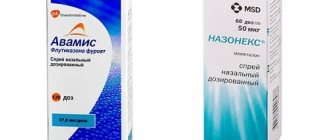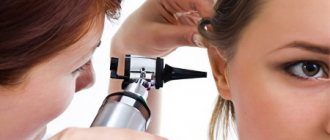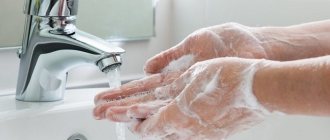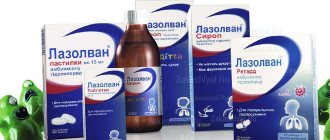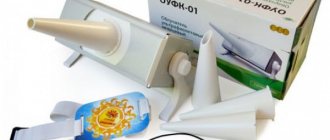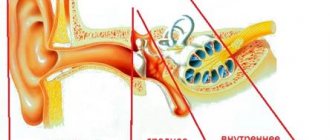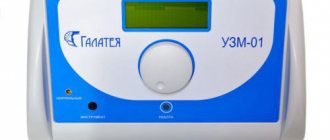Effective ear drops
There are many different ear drops with different directions of action:
- Boric alcohol and - means that disinfect the ear canal and have a local warming effect.
- Perfectly softens wax plugs and disinfects the ear canal, helps to clean the ear well if there is a lot of hard and dense wax that is difficult to remove.
- contain carbolic acid and have a powerful disinfectant effect.
- Sofradex has a pronounced antibacterial effect, which precludes its use for viral or fungal causes of the disease.
- Otinum, Tsipromed, Otofa also fight bacterial infection. Their prescription can only be made by a doctor who is knowledgeable about the nature of the patient’s ear disease, always taking into account the patient’s age, since some drugs are prohibited for young children.
How to administer ear drops to an adult
If the doctor has already made a diagnosis and prescribed a specific drug, treatment can begin. Sometimes it may be necessary to clean the ear canal. This procedure must be carried out with the utmost care to remove contaminants only from the desired areas. If discomfort occurs during such manipulation, it should be stopped.
The main condition for how to instill drops is to preheat the medicine before instillation. A cold remedy will make the sensation unpleasant and may also increase inflammation. Typically the drops are heated by placing them in a bowl of warm water. If you need to soften or rinse your ear with peroxide, it can be at room temperature. Boric alcohol must be heated, since it itself is a warming agent.
Procedure:
- the person lies on his side so that the sore ear is on top;
- the auricle rises and is pulled to the side;
- the required amount of medicine is drawn into a pipette or dropper, after which as many drops are instilled into the ear as prescribed by the doctor;
- During the procedure, you need to ensure that the drops flow down the ear canal;
- the treated organ is closed with a cotton swab (if the other ear needs to be instilled, this condition is mandatory);
- the patient can turn on the other side or stand up only after 2–3 minutes, the best option is after about 15 minutes.
After getting up, the patient may experience discomfort in the ear, dizziness, minor disruptions in the functioning of the respiratory system, and so on. In such a situation, a person needs to lie down or just sit quietly in a position that is comfortable for him.
How to put drops in your ears correctly
Important: you should absolutely not put any liquids into your ears, except for medications prescribed by the doctor.
No folk remedies, from instilling walnut oil to applying urine compresses, have anything to do with the treatment of ear diseases. On the contrary, they can lead to sad consequences: in the best case, otitis media will become chronic, in the worst case, it can result in hearing loss and purulent meningitis.
So, the diagnosis has been made, treatment has been prescribed, ear drops have been purchased at the pharmacy, all that remains is to instill them correctly by following these steps:
- Wash your hands thoroughly with soap to avoid additional infection of an already sore ear.
- Gently clean the auricle and ear canal from wax and other contaminants using a damp cotton pad.
- Warm the bottle of medicine by holding it in your hand or immersing it in warm water to a temperature equal to body temperature. Cold liquid causes ear irritation and pain, and may cause dizziness. Be careful not to overheat the medicine; hot drops can cause burns to the ear canal and inner ear.
- If the drug is for instillation in the form of a suspension, the bottle must be shaken thoroughly to evenly distribute the active substance in the solution.
- Make sure that the tip of the dropper on the bottle with ear drops does not have chips or cracks that could injure the ear canal. When using a regular pipette, it must first be sterilized by boiling.
- Turn the bottle over so that the medicine is at the tip of the dropper.
- The head should be tilted upward with the affected ear or the patient should be placed on the appropriate side.
- To facilitate the penetration of drops, it is necessary to straighten the ear canal by pulling the ear back and up with your free hand (for a child under two years old - back and down).
- Place the prescribed number of drops into the ear and lightly press the tragus so that the medicine moves along the ear canal.
- Remove excess drops with a turunda.
- To increase the duration of the drug’s effect on the eardrum, it is recommended to lie on the healthy side for 10 minutes or insert a cotton swab into the ear drop.
- After the procedure, you must immediately close the bottle of medicine.
- Wash the hands.
Important: The instilled drug must pass along the outer wall of the ear canal, since direct contact of ear drops directly on the eardrum can cause a sharp increase in pain, dizziness and a headache.
General rules for preparation and conduct
Before carrying out the procedure, you should know the correct dosage of ear drops for children. It is determined by the doctor based on the composition of the drug. Also, each instruction contains a description of how much to drip depending on the age of the baby.
General rules for preparing and conducting instillation are as follows:
- Ear medications should be at room temperature, not cold. If they are stored in the refrigerator according to the instructions, then you should take them out an hour before instillation and hold them in your hand before the procedure so that the liquid warms up. You can also pour a small amount of the medicine onto a hot spoon to warm it up, but it is important not to overheat the drops, as this may cause them to lose their properties.
- When using a glass pipette, you should pour boiling water over it to prevent infection in the ear canal.
- First you need to prepare several balls of clean cotton wool, which will be needed at the end of the procedure.
What to do first
To do this, you must first place the patient on a bed or sofa. After this, it is recommended to wash your hands thoroughly with soap. Then the patient needs to clean the canal in each ear from accumulated wax. If this is not done, the substance that has accumulated in the ear canal may become an obstacle to the penetration of the medicine into the affected area. To do this you need to do the following:
- Take a cotton swab in your hands.
- Deepen it into the canal of one ear. But not to a great depth, otherwise you can damage the eardrum.
- Rotate the stick around its axis and remove it from the auricle.
If there is no wax, you can thoroughly wipe the ear with a soft, damp cloth.
This must be done carefully, especially if the sick small child.
Restrictions
Ear drops can be used in many situations. However, when you have a damaged eardrum or ear plug, avoid using ear drops unless approved by your doctor.
If the eardrum is perforated, most antibiotics and painkillers are contraindicated because they can damage the contents of the inner ear. If you have a viral or fungal infection, avoid using hydrocortisone.
Symptoms of a ruptured eardrum include:
- pain;
- discharge from the ear;
- noise in ears;
- sharp attenuation of pain and changes in pressure in the ear;
- hearing impairment.
For a perforated membrane, you can use Ciprodex and Uniflox. These drugs are considered safe and do not damage the inner ear. However, this treatment should only be used under the supervision of a doctor.
The next stage of drug use
To warm up a cold bottle, simply place it in a cup of hot water for 10 minutes. Some types of drugs can be held in your hands during this time; they perceive human warmth. Perhaps the medicinal substance in the bottle has the consistency of a suspension. In this case, you need to shake the container with the medicine for 10 minutes. After all these procedures have been completed, you can begin the main actions.
How to give yourself a drop
If you do not have a person who could help you in this matter, then you can try to perform the manipulation yourself. To do this, you must follow the following action plan:
- Check the integrity of the bottle containing the drops. It is also necessary to verify the functionality of the pipette.
- Take a horizontal position so that the affected ear is on top.
- Using your fingers, pull your ear back and up so that the ear canal is as open as possible.
- According to the instructions, draw the solution into a pipette. Press your index finger on the goat and send the drug into the ear canal. Such actions will allow you to drip the solution as deep as possible.
- Stay in a lying position for a few more minutes, while keeping your head tilted. You can also install fleece.
What ear drops should be used first for perforation of the eardrum is described in this article.
But this information will help you understand how to use Otofa ear drops.
What reviews about Dancil ear drops currently exist and how positive they are, information from this article will help you understand: https://lechim-gorlo.ru/u/lechenie-u/dancil-ushnye-kapli-instrukciya-po-primeneniyu. html
This article describes which inexpensive ear drops for otitis media are the most popular and effective.
Features of the use of drugs
Before starting treatment, you need to warm up the drops.
Attention! Too cold or hot products can cause severe pain. So be sure to warm it up to body temperature. Since the active ingredients in some medicines may settle, try to shake the medicine well.
There are some features when instilling certain compounds:
- Hydrogen peroxide
. To clean the ear canal, you can use a gauze pad or a cotton pad soaked in the composition. The procedure can be carried out no more than once every 10 days. After treatment, the ear must be cleaned of the contents with a dry, clean cloth. If you decide to instill peroxide, you can dilute it in a 1:1 ratio or use it undiluted. After 10-15 minutes, when the hissing stops, tilt your head in the opposite direction so that the residue can flow out freely. - Alcohol tinctures
. They cannot be used with. Since such compositions have a warming effect, use a cotton pad or bandage after the procedure. You cannot be in a draft for two hours. If you plan to go outside, protect your ears. Alcohol tinctures should be stored in a dark glass bottle.
The medications presented in pharmacies are already ready for use, but sometimes dilution of the drug is required. For example,
When an ear hurts, the patient consults a doctor for treatment. One of his prescriptions will be ear drops. The instructions for use indicate that the medicine helps to reach the source of inflammation within a short time and treat the disease.
The next stage of drug use
Usually, the instructions for the drops that the doctor prescribes for instillation into the ears state that the drug must be heated to 37 °C. It is forbidden to pour too cold a medicinal solution into the ears. Also, do not use a very hot mixture, as it can severely burn the inside of the ear canal. Therefore, the optimal temperature will be the temperature of the human body, since too cold or hot a medicinal liquid can cause dizziness, pain, and sometimes loss of consciousness in the patient, especially if this drug is to be given to a child.
To warm up a cold bottle, simply place it in a cup of hot water for 10 minutes. Some types of drugs can be held in your hands during this time - they perceive human warmth. Perhaps the medicinal substance in the bottle has the consistency of a suspension. In this case, you need to shake the container with the medicine for 10 minutes. After all these procedures have been completed, you can begin the main actions.
Benefits of treating ear diseases with drops
Otitis media, which occurs in every child at least once in their life, is mainly treated with drops. If the process is carried out incorrectly, it will not be possible to achieve a therapeutic effect. Therefore, a parent should know some features of how to properly put drops into their child’s ear and not cause harm.
Ear diseases almost always cause pain and a possible increase in body temperature in a child. To reduce discomfort and pain in the baby, local therapy is used.
The advantages of treatment with drops are as follows:
- pain is reduced;
- the inflammatory process in the ears decreases, since the drops act on the source of the infection, destroying it from the inside;
- the possibility of using ear drops from birth (the medicine acts locally and is practically not absorbed into the blood);
- affordable price and economical use of the medicine (almost every product has a special dropper cap, which makes the drug easier to use).
Despite the ease of use and availability of such products, it is worth consulting an otolaryngologist before using them in children in order to avoid negative consequences.
Benefits of treatment with ear drops
Any inflammatory processes in the ears are always accompanied by pain, burning, irritation - all this greatly affects the patient’s quality of life. It is necessary to use local drugs - ear drops, which act most quickly in the treatment of ear diseases.
The main advantages of drugs in the form of drops:
- reduction of inflammation;
- direct impact on infection and its elimination;
- elimination of symptoms of the disease;
- action exclusively at the site of inflammation;
- low absorption into the blood;
- Possibility of use by children and pregnant women;
- budget price;
- slow consumption;
- availability in pharmacies.
Almost all patients with ear inflammation are prescribed outpatient treatment, so they must know how to instill properly. This will help avoid various mistakes and speed up recovery.
Video: How to properly place drops in a child’s ears
Ekaterina Morozova
Reading time: 10 minutes
A A
According to medical statistics, every toddler under the age of 1 year experiences otitis media.
The disease can be quite severe, and often with consequences, so every mother should know the basic rules for instilling medicine in her child’s ears for otitis media.
Nasal drops
When instilling the nose, you must first clear the nasal passage of mucus. It is also important to wash your hands with soap and water. It is necessary to perform the manipulation with an assistant, as this will reduce the likelihood of errors.
After this, be sure to check the expiration date of the drug used. Pipette the medicine in the amount prescribed by your doctor. Turn your head towards your shoulder and pull it back slightly. Make sure that the desired nasal passage is higher.
Now you can send the medicine directly into the nasal passage. Press the wing of the nostril with your fingers and stay in this position for several minutes. Carry out similar actions with the other nasal passage.
Types of drugs
When choosing a drug, you should always consult your doctor
In otolaryngology, the following groups of drugs are widely used in the form of solutions for topical use:
- Antibacterial (“Fugentin”, “Tsipromed”, “Normax”). The drugs are active against most pathogens of ear pathologies; in mild cases of the disease they are successfully used instead of systemic antibiotics.
- Anti-inflammatory (“Otinum”, “Otipax”). Steroid and non-steroidal medications effectively eliminate pain, itching and burning, and relieve swelling.
- Combined ones (“Candibiotic”, “Dexon”, “Polydexa”). Medicines have simultaneously antimicrobial, anti-inflammatory and/or antifungal effects.
Any drug is prescribed by a doctor based on a confirmed diagnosis, the severity of the disease and the individual characteristics of the patient. If purulent discharge appears or an allergic reaction develops (itching, skin rashes, increased swelling), the use of the medication should be stopped and consult a specialist.
Important! Uncontrolled use of ear drops is prohibited. Most drugs can only be used in the absence of damage to the eardrum, since penetration into the cavity of the inner ear causes damage to the auditory nerve, up to complete deafness.
Prevention of ear plugs
To prevent the appearance of wax plugs, infrequent mechanical cleaning of the external auditory canal of the child’s ears is recommended; it should be carried out 1 day. in Week. Under no circumstances should sharp metal objects (tweezers, bobby pins) be used for this purpose. Use special children's sticks with limiters. You can lightly moisten them with water. Clean your child's ears very carefully. Remove only what has come out; under no circumstances should you penetrate deep into the ear canal.
Treatment of ear diseases cannot take place without medications. Modern drug manufacturers offer convenient dosage forms that allow you to quickly and effectively cure most ailments. Basically we are talking about drops.
Types of effective ear drops
There are a large number of ear drops that have different medicinal properties.
Camphor oil
Camphor oil, used in the treatment of ear diseases, normalizes blood circulation in the affected area and accelerates metabolic processes, eliminating excess intercellular fluid in the tissues. This helps restore the patency of the ear canal. Camphor oil is an excellent remedy for the regeneration of damaged tissues.
Boric alcohol
Boric acid, which is the basis of the drug, is a powerful antiseptic that eliminates harmful microorganisms. Boric alcohol is used in the treatment of acute otitis without complications. This medicine warms up the affected area well.
Hydrogen peroxide
Hydrogen peroxide is a disinfectant widely used to treat ENT diseases. It is used to soften wax plugs in the ear and disinfect the ear canal itself. Experts advise cleaning your ears with peroxide in situations where there is a lot of hard and difficult-to-remove wax.
Otipax
Medicine in the form of drops, which includes:
- carbolic acid, which has disinfectant properties;
- phenazone;
- lidocaine.
The last two components can increase the duration of the anesthetic effect during treatment, completely eliminate the inflammatory process and shorten the recovery time.
Sofradex
An antibacterial drug that cannot be used to treat viral or fungal diseases.
Tsipromed, Otinum, Otofa
All three medications have approximately the same properties - they destroy bacterial infections. Only a specialist who has given the patient a correct diagnosis, taking into account his age, can prescribe such drops, because young children are prohibited from being treated with certain medications.
Normax
Antibacterial drops used to treat external inflammation and. Normax has a bactericidal effect, completely killing harmful microorganisms.
As a result, the inflammatory process is suppressed and the patient recovers. Part of the medicine affects only the area of application, and the rest is absorbed into the blood. The drug is excreted through the kidneys.
Drops in the ear: how to choose and use them correctly
Health is the greatest value for a person. Therefore, disruption of the functioning of any organ can lead to the most negative consequences. An example of such unpleasant and dangerous disruptions of the body are various ear diseases. Almost always, in the treatment of such diseases, in addition to antibiotics and flagella, drops in the ears are also effectively used. But first you need to carefully figure out how to choose them correctly so as not to harm a person.
At home
The most common diseases are ear inflammation and otitis media. In cases where it is necessary to help a person at home (if it is impossible to consult a doctor), alcohol tinctures of peppermint and calendula (marigold) flowers are often used, as well as a 3% solution of boric acid or heated sunflower oil. It is very important that the drops in the ear are warmed to body temperature. Otherwise, they can cause irritation of the lining of the inner ear and brain, which manifests itself in convulsions or dizziness. Drops are used when there is no suppuration from the ear.
Ready-made drugs
Ready-made medications prescribed by an otolaryngologist include Albucid, Otipax, Sofradex, and Otium drops. They contain antibacterial and analgesic components. Solutions of polymyxin and etonium, resorcinol and rivanol are also used. They help to liquefy the discharge in the tympanic cavity, helping to cleanse the mucous membrane of inflammation and pus. But other medicinal treatment must be a mandatory addition to the drops. It is very important that the patient's nose is cleared of mucus. For this, various vasoconstrictor drops are used. Also, flagella impregnated with medicine are inserted into the ear for an additional analgesic and anti-inflammatory effect.
Traditional methods of treatment
For any disease, there are ways to get rid of them in traditional medicine. So, for pain in the ears with lumbago, use a well-heated red brick or a flat stone wrapped in cloth. It is applied to the sore spot. It needs to be held for about two hours. The patient should also use any diaphoretic. Very often boiled sunflower oil is used for treatment. These drops are instilled into the ear for otitis media and for pain during a cold. The following folk remedies are very common: solutions of propolis and mumiyo with oil, beeswax, honey, ash juice, aloe and flax seed, peony and calamus roots, birch buds.

